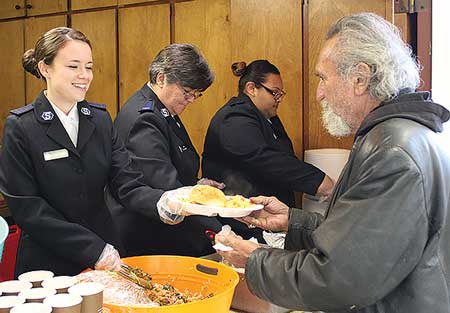Jones talks dollars, sense
Major Bruce Jones, territorial financial secretary, informed and enlightened Territorial Business Conference delegates with his presentation of the territory’s current fiscal picture. He called it “A nickel ain’t worth a dime anymore” – or “Show us the money.”
Jones, a holder of advanced degrees in business and a state license as a certified public accountant, used both graphs and charts and his dry wit to help his listeners understand complex facts.
His initial question was: “Where is the money?”—and here he listed, examined and explained the principal sources of income within the territory. He summarized this with the following conclusions:
“The Army continues to receive significant legacy income. Field units receive the majority of legacies and increasingly use them for operational costs.” A graph revealed that legacy income was the second highest source of operating income.
“Portfolio management in the future,” Jones said, “will focus on long-term growth with more conservative interest to field accounts.” It is the fourth highest source of operating income.
“Support Services (the tithe each unit contributes to the next higher supervising headquarters) is the administrative, supervision and consultation given by various headquarters of The Salvation Army – national, territorial and divisional.” Jones stated: “Administration will need to fund from other sources in the future.” He used a graph to indicate that Support Service was the highest source of operating income.
”World Service is vital to the worldwide Army mission, and must by supported by financially independent territories.
“Insurance will continue to rise and is a major cause for risk control and coordinated national planning.”
Jones then addressed the question: “Where is the money?” Here, he explored a range of difficult fiscal challenges facing the Army and identified some future funding directions. These included such matters as “asset leverage, (land and buildings, rentals) social entrepreneurship (successful non profits are operated as businesses), Internet/tel-emarketing (we are currently raising less than one-tenth of one per cent here while the Red Cross raises millions), endowments (can be a permanent source of funds to support programs), and major gifting (which must be a larger component of public contributions).”
Looking at current money sources, he noted that the United Way is “less than 3% of our income”—that “there is no increase in net real income from direct mail”—that “public funds are mostly cost reimbursement” and that sales to the public are limited due to “competition and cost of production.”
Jones made it very clear that the portfolio will not save us. He stated: “Market losses over the last three years have consumed the THQ unrestricted net assets,” that “THQ distributed much of market gains to the field during 1997 to 2001,” and that future portfolio planning will focus on long term returns with planned pay out rates to constituent accounts.”
Jones concluded with four points: (1) more money = more mission; (2) significant financial challenges require dramatic fiscal change; (3) to provide more money for mission we must operate as a business with sound financial management practices; (4) endowment building and ‘outside the box’ funding methods will assist our return to fiscal soundness.












